Greyhawk, also known as the World of Greyhawk, is a fictional world designed as a campaign setting for the Dungeons & Dragons fantasy roleplaying game. Although not the first campaign world developed for Dungeons & Dragons—Dave Arneson's Blackmoor campaign predated it by about a year—the world of Greyhawk closely identified with early development of the game beginning in 1972, and after being published it remained associated with Dungeons & Dragons publications until 2008. The world itself started as a simple dungeon under a castle designed by Gary Gygax for the amusement of his children and friends, but it was rapidly expanded to include not only a complex multi-layered dungeon environment, but also the nearby city of Greyhawk, and eventually an entire world. In addition to the campaign world, which was published in several editions over twenty years, Greyhawk was also used as the setting for many adventures published in support of the game, as well as for RPGA's massively shared Living Greyhawk campaign from 2000–2008.
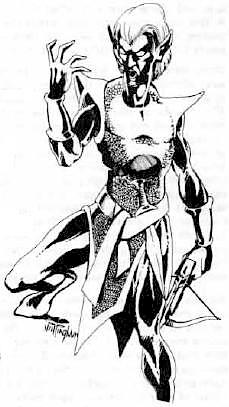
The drow or dark elves are a dark-skinned and white-haired subrace of elves connected to the subterranean Underdark in the Dungeons & Dragons fantasy roleplaying game. The drow have traditionally been portrayed as generally evil and connected to the evil spider goddess Lolth. However, later editions of Dungeons & Dragons have moved away from this portrayal and preassigned alignment. More recent publications have explored drow societies unconnected to Lolth.
The Underdark is a fictional setting which has appeared in Dungeons & Dragons role-playing campaigns and Dungeons & Dragons-based fiction books, including the Legend of Drizzt series by R. A. Salvatore. It is described as a vast subterranean network of interconnected caverns and tunnels, stretching beneath entire continents and forming an underworld for surface settings. Polygon called it "one of D&D's most well-known realms".

Dungeonland (EX1) is a 1983 adventure module for the Dungeons & Dragons (D&D) roleplaying game, written by Gary Gygax for use with the First Edition Advanced Dungeons & Dragons (AD&D) rules. It is an adaptation of Lewis Carroll's 1865 novel Alice's Adventures in Wonderland, with the various characters from the book translated into AD&D terms.
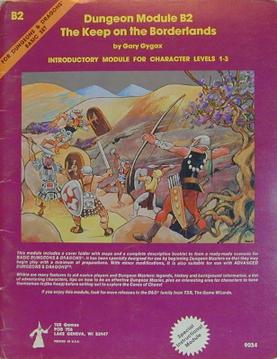
The Keep on the Borderlands is a Dungeons & Dragons adventure module by Gary Gygax, first printed in December 1979. In it, player characters are based at a keep and investigate a nearby series of caves that are filled with a variety of monsters. It was designed to be used with the Dungeons & Dragons Basic Set, and was included in the 1979–1982 editions of the Basic Set. It was designed for people new to Dungeons & Dragons.
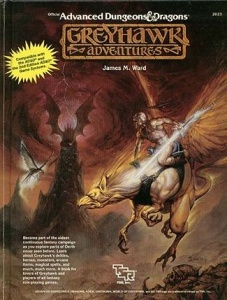
Greyhawk Adventures is an accessory for the Advanced Dungeons & Dragons (AD&D) World of Greyhawk campaign setting.

Scourge of the Slave Lords (A1–4) is an adventure module for the Dungeons & Dragons fantasy role-playing game, published by TSR, Inc. in 1986. It combines the contents of four earlier modules, all set in the World of Greyhawk campaign setting and intended for use with Advanced Dungeons & Dragons first edition rules.
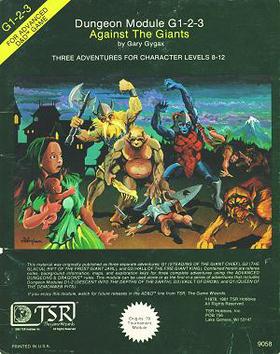
Against the Giants is an adventure module written by Gary Gygax and published by TSR in 1981 for the Dungeons & Dragons fantasy role-playing game. It combines the G series of modules previously published in 1978: Steading of the Hill Giant Chief, Glacial Rift of the Frost Giant Jarl, and Hall of the Fire Giant King. All three were produced for use with the 1st edition Advanced Dungeons & Dragons rules. In 1999, to recognize the 25th anniversary of TSR, the company released an updated version, Against the Giants: The Liberation of Geoff. Later in 1999, Wizards of the Coast published a novelization of Against the Giants by Ru Emerson.
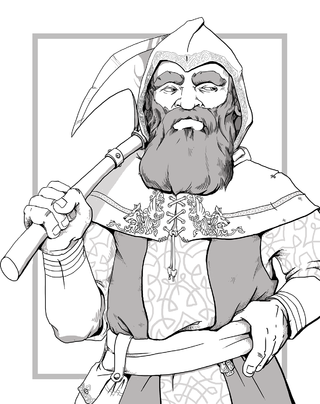
A dwarf, in the Dungeons & Dragons (D&D) fantasy roleplaying game, is a humanoid race, one of the primary races available for player characters. The idea for the D&D dwarf comes from the dwarves of European mythologies and J. R. R. Tolkien's novel The Lord of the Rings (1954-1955), and has been used in D&D and its predecessor Chainmail since the early 1970s. Variations from the standard dwarf archetype of a short and stout demihuman are commonly called subraces, of which there are more than a dozen across many different rule sets and campaign settings.
The flexibility of the Dungeons & Dragons (D&D) game rules means that Dungeon Masters (DM) are free to create their own fantasy campaign settings. For those who wanted a pre-packaged setting in which to play, TSR, Wizards of the Coast (WotC), and other publishers have created many settings in which D&D games can be based; of these, the Forgotten Realms, an epic fantasy world, has been one of the most successful and critically acclaimed settings. Many campaign settings include standard sword and sorcery environments, while others borrow Asian, Central American, swashbuckling, horror and even space-travel themes.

White Plume Mountain is an adventure module for the Advanced Dungeons & Dragons fantasy role-playing game, written by Lawrence Schick and published by TSR in 1979. The 16-page adventure bears the code "S2". The adventure is a dungeon crawl where the players' characters are hired to retrieve three "notorious" magical weapons, each possessing its own intelligence. The adventure contains art by Erol Otus, and a cover by Jeff Dee. A sequel, Return to White Plume Mountain, was published in 1999, and an updated version conforming to v3.5 rules was released online in 2005. The original was again updated for the 5th edition in 2017 as the fourth part of Tales from the Yawning Portal.

The Forgotten Temple of Tharizdun is an adventure module for the Dungeons & Dragons (D&D) role-playing game, for use in the World of Greyhawk campaign setting. The module was published by TSR, Inc. in 1982 for the first edition Advanced Dungeons & Dragons rules.
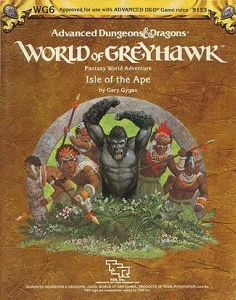
Isle of the Ape is an adventure module for the Dungeons & Dragons role-playing game World of Greyhawk campaign setting, in which the events occur in a magical demiplane of the same name created by the mad archmage Zagyg Yragerne.

In the Dungeons & Dragons fantasy role-playing game, giants are a collection of very large humanoid creatures based on giants of legend, or in third edition, a "creature type".
The Dungeons & Dragons (D&D) fantasy role-playing game has been adapted into many related products, including magazines, films and video games.
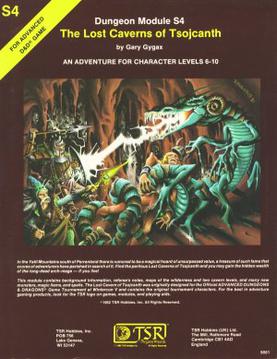
The Lost Caverns of Tsojcanth is an adventure module for the Dungeons & Dragons fantasy role-playing game. It was written by Gary Gygax and published by TSR in 1982 for the first edition Advanced Dungeons & Dragons (AD&D) rules. The 64-page adventure bears the code "S4" and is set in the Greyhawk campaign setting. It is divided into two parts, a 32-page adventure, and a 32-page booklet of monsters and magic items. The plot involves the player characters investigating rumors of lost treasure. After traversing a wilderness and two levels of dungeons, the players face Drelnza, the vampiric daughter of long-deceased archmage Iggwilv.
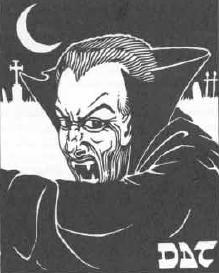
In the Dungeons & Dragons fantasy role-playing game, a vampire is an undead creature. A humanoid or monstrous humanoid creature can become a vampire, and looks as it did in life, with pale skin, haunting red eyes, and a feral cast to its features. A new vampire is created when another vampire drains the life out of a living creature. Its depiction is related to those in the 1930s and 1940s Hollywood Dracula and monster movies. In writing vampires into the game, as with other creatures arising in folklore, the authors had to consider what elements arising in more recent popular culture should be incorporated into their description and characteristics.
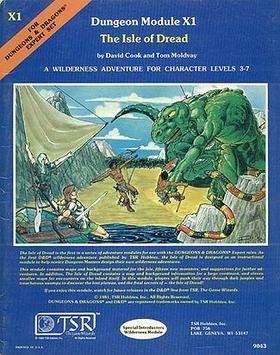
The Isle of Dread is an adventure for the Dungeons & Dragons role-playing game. The adventure, module code X1, was originally published in 1981. Written by David "Zeb" Cook and Tom Moldvay, it is among the most widely circulated of all Dungeons & Dragons adventures due to its inclusion as part of the D&D Expert Set. In the adventure, the player characters arrive on the Isle of Dread seeking a lost treasure, and there encounter new nonhuman races.
Tritons are a fictional species in the Dungeons & Dragons fantasy role-playing game.

Dragons of Despair is the first in a series of 16 Dragonlance adventures published by TSR, Inc. (TSR) between 1984 and 1988. It is the start of the first major story arc in the Dragonlance series of Dungeons & Dragons (D&D) role-playing game modules, a series of ready-to-play adventures for use by Dungeon Masters in the game. This series provides a game version of the original Dragonlance storyline later told in the Dragonlance Chronicles trilogy of novels. This module corresponds to the events told in the first half of the novel Dragons of Autumn Twilight by Margaret Weis and Tracy Hickman. Its module code is DL1, which is used to designate it as the first part of the Dragonlance adventure series.














